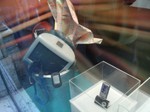Wow, a year has passed since I last had the honor to host the Carnival of the Mobilists on my site. Last time I got the heads up for hosting the Carnival via eMail while sitting in a taxi on the way from Lisbon airport to the city center. This time around, Rome’s the place, and my notebook is wirelessly connected via HSDPA.
It has been a great time since then in many ways and people contributing to the Carnival have sparked many great thoughts and ideas in me. The Carnival has also been invaluable to me in finding new people entering the mobile space and helped me a lot to keep my blog roll fine tuned to my interests and the ever growing, sometimes shrinking, but greatly evolving blog sites on mobile out there on the web. So thanks to all of you contributing to the Carnival and I hope you enjoy this week’s selection again:
- Nokia’s Transition To An Internet / Computer Company: Not to miss, and thus my favorite post of the week, is Michael Mace‘s analysis at Mobile Opportunity of Nokia’s transition process which top managers of the company keep mentioning to the press.
- Open Motorola: A lot of articles in this and previous Carnivals on Nokia so I was delighted to see Jason Devitt of Skydeck submitting an article about open OS platforms being pushed by Motorola.
He doesn’t only discuss platform strategy for the 2007 Motorola device
collection but also what OEMs are doing to get a presence in the
wireless market.
- Innovate Europe 07: Rudy de Waele of m-trends.org must have had an exhilarating and busy week at Innovate Europe 07 as it seems he aimed for the Guinness Book of Records with the length of his blog post. His post contains tons of interesting information and is well structured so you’ll find the pieces of information that interest you very quickly.
- MobileCampNYC: More meeting and conference reporting: Marshall Sponder of SmartMobs has posted his impressions of MobileCampNYC which took place this week. Too bad New York is so far away from here, looks like it was worth going.
- Widgets: Sprung over from PCs to mobiles a hot discussion has set in on whether they are useful or not, about their advantages and shortcomings and if they are going to be the killer application for mobile (do they attempt to be?). Ian Wood, aka the Digital Evangelist discusses his thoughts after returning from a Mobile Monday London on the topic.
- AOL Mobile Portal Review: Dennis over at Wap Review has a great blog where he reports about hot new stuff for your mobile web browser. His contribution to this week’s Carnival deals with AOL’s mobile portal and how the services there compare and compete.
- Web 2.0 Micro Payment: Mobile Web 2.0 evangelist Ajit Jaokar writes about content discovery on YouTube and about finding a song/video so dear to him that he had to keep listening/viewing all afternoon. Dreaming aside he starts thinking about how producer, artist and distributer could be paid for their effort and his pleasure. Check it out at his Open Gardens blog.
- Bluetooth and Spam: Tim Trent over at "Marketing by Permission" takes a look at Technorati statistics of blog entries mentioning "Bluespan", "Bluecast" and "Proximity Marketing". Interesting information for mobile marketeers.
- S60 Font Sizes: Ever thought the fonts on your S60 phone should be bigger or smaller? Zach over at "Symbian in Motion" reports about a new tool that does just that for you.
- Hardware/Software Bugs: The functionality of mobile phones
keeps growing and growing which is both good and bad. The down side is
of course that the more stuff is inside the more can break. Tarek El Ghazali from "Symbiano-Tek" reports some trouble with his N80 that keeps forgetting time and date.
- Warranty Service For That Mobile Computer: Ricky Cadden of "Symbian-Guru.com" writes about his bad experiences with the NokiaUSA warranty service.
I have to agree with him, 24 days return time for a broken N-series
mobile is not acceptable. Nokia claims their n-series devices
replace computer, camera, maps, etc. etc. That’s nice but it also
creates a single point of failure that needs to be fixed ASAP an not in
24 days…
- The World Before And After The iPod: I very much like Tomi Ahonen‘s thoughts about mobile on his "Communities Dominate Brands" site. This week he features an exciting article in which he postulates that soon mobile history will be seen as a time before the iPhone and a time after the iPhone. An article not to be missed.
- The Mobile But Non Web Device: In contrast to the article before, Barry Welford over at "Stay Go Links" argues that the mobile web is only a thing for geeks and companies should rather concentrate on developing a keyless phone just for making phone calls and not much else. He must feel a bit lonely with his opinion among the other articles in the Carnival this week. Nevertheless, his blog entry contains some interesting points!
- JavaFX: Sun seems to have decided to enter the mobile phone OS market. Competition is good and David Beers over at "Software Everywhere" takes a critical look at JavaFX, a mix of Linux and Java.
- U.S. Wireless Data Revenues: Chetan Sharma reports the latest numbers from wireless operators (sorry, wireless carriers) in the U.S. on "Always On Real-Time". 5 billion dollars revenue from mobile data services in the last quarter, 60% of it from non-SMS revenue. Here are the details.
- Where To Store The Data: Mark Wickersham sent in a post for Barbara Ballard of "Little Springs Design" with an introduction of where to developers should store their data. "local, server, and mixed mode applications" is the title of the post.
- Mobile Music Store Marketing: Xen Mendelsohn of "Xellular Identiy" reports on Sprint’s advertisement campaign for their new mobile music store. Looks like it’s a clever melange of virtual characters, MySpace and of course, music.
- HSDPA Performance: Those of you who already know my blog will probably not be surprised by my own blog entry for the Carnival this week. Since I am a network guy I tend to look at the wireless world from "the other side" = "the network side". So here’s the latest part of my ongoing series on reporting on HSDPA performance in live networks.
Wow, what a selection again this week, I hope you enjoyed it! We are almost at the end of the post and I have changed location in the meantime from Rome to Paris. Next week, Andreas Constantinou of the VisionMobile Forum will host the carnival.
And last but not least, if you want to submit a story of your own, send an eMail by next Friday to "mobilists at gmail.com" or use the carnival form here.




